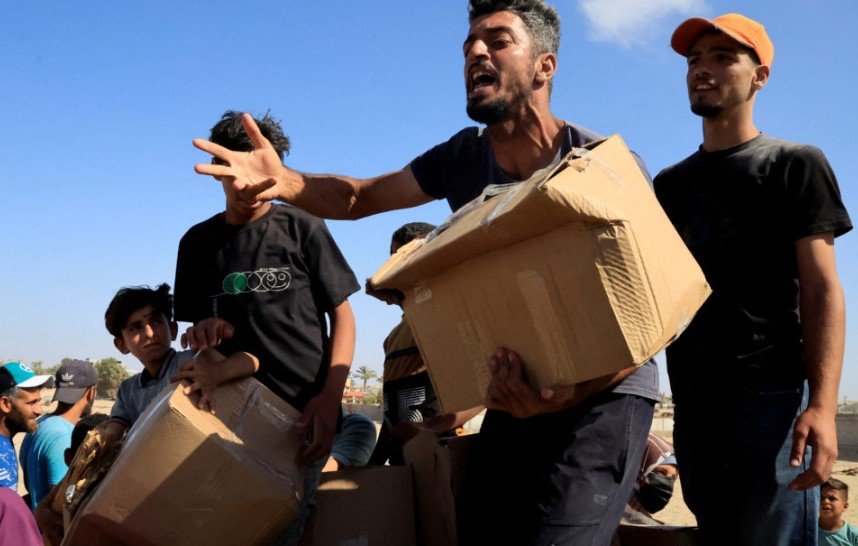Israel’s military is setting up two new aid distribution centers in Rafah, southern Gaza, as part of an effort to support residents fleeing from Gaza City amid ongoing conflict. These sites, run by the Gaza Humanitarian Foundation, aim to expand a program that has already provided over 150 million meals since early 2025, but the initiative has sparked controversy due to past incidents of violence and chaos at similar locations.
Background on the Gaza Humanitarian Aid Effort
The Gaza Humanitarian Foundation started operations in May 2025, backed by the United States and Israel, to deliver food and supplies directly to civilians in Gaza. This came after months of restricted aid flows that worsened famine conditions for over two million people.
Foundation workers have distributed meals, water, and medical kits through secure compounds, focusing on areas under Israeli military control. By September 2025, the program reached a milestone of 150 million meals, according to recent updates. This expansion responds to the latest evacuations ordered by the Israel Defense Forces, urging Gaza City residents to move south for safety.
Officials say the foundation prevents aid from reaching militant groups like Hamas. Yet, critics argue it politicizes humanitarian help, with some international experts calling for its dismantling over concerns about access and fairness.

Details of the New Rafah Sites
Construction began in early September 2025 on two new compounds in Rafah, a area heavily damaged by fighting. The sites sit between key corridors, including the Philadelphi route along the Egypt border, in zones cleared of buildings and secured by the military.
Workers use heavy equipment to build enclosures with sand berms, guard posts, and armored access points. American security teams, operating white armored vehicles, oversee the sites to ensure safe distribution.
Each compound is designed to serve up to 300,000 people with daily essentials. Here are key features of these new aid centers:
- Walled perimeters with surveillance cameras for security.
- Distribution points for food, water, and hygiene kits.
- On-site medical tents for basic care.
- Inspection areas to screen entrants and prevent misuse.
These additions will bring the total number of active sites to six, scaling up operations as more evacuees arrive from the north.
The sites incorporate water pipelines from Egypt, funded by the United Arab Emirates, to provide desalinated water. Military officials expect the compounds to be operational within days, ready to handle increased demand from displaced families.
Controversies Surrounding the Program
The Gaza Humanitarian Foundation has faced sharp criticism since its launch. In May 2025, crowds stormed a new site in Rafah, leading to torn fences and chaotic scenes captured in videos. International agencies accused the program of weaponizing aid by tying it to military control.
United Nations experts in August 2025 urged shutting down the foundation, citing failures in international humanitarian law. They pointed to incidents where deadly fires near aid centers raised questions about responsibility.
| Incident | Date | Location | Details | Outcome |
|---|---|---|---|---|
| Crowd Storming | May 27, 2025 | Rafah | People overran fences for supplies | Site temporarily closed for security upgrades |
| Deadly Fire | June 2025 | Tel Sultan, Rafah | Fire near distribution point, videos showed chaos | Resumed operations after 24-hour pause, with added guards |
| Security Closure | August 2025 | Multiple sites | Boosted measures after violence | UN called for dismantling, citing moral failures |
Supporters argue the program fills gaps left by blocked traditional aid routes. Israeli officials claim it has saved lives by bypassing groups that divert supplies.
Despite the backlash, the foundation resumed distributions after brief closures, adding measures like biometric checks to control access.
Balance comes from voices like local residents who describe the sites as vital yet overcrowded. One Gaza family shared stories of waiting hours for meals, highlighting both relief and frustration.
Impact on Gaza Residents and Evacuations
As Israel expands its offensive in Gaza City, leaflets dropped on September 9, 2025, ordered about two million people to head south to areas like Al Mawasi near Rafah. This mass movement strains existing resources, making the new sites crucial.
Evacuees face destroyed landscapes in Rafah, once home to 200,000, now a wasteland of rubble and stray animals. The quiet there contrasts with northern explosions, but challenges remain, including limited space and feral dog packs.
Aid from these sites includes supplemental feeding programs to combat malnutrition. Families receive blankets, tents, and medicine, helping them settle in expanded humanitarian zones with field hospitals.
However, overcrowding leads to “suffocating” conditions, as one resident put it. Logical reasoning suggests that without these sites, famine risks would spike, given the blockade’s history since October 2023.
Recent events, like UAE aid convoys entering through Rafah in early September 2025, show growing international involvement. This ties into broader efforts, such as quiet coordination by groups like IsraAID, which has secured supplies for over a year without foundation ties.
Future Implications for Gaza Aid
Looking ahead, the new sites could reshape aid delivery in Gaza, potentially serving as models for post-conflict recovery. If successful, they might expand to northern areas once secured.
Challenges persist, including calls from groups like the Friends Committee on National Legislation to end what they see as aid weaponization. The program’s future depends on balancing security with open access.
Experts predict that by late 2025, aid needs could double if evacuations continue. Israel plans more water lines and electricity boosts to support the zones.
In the end, this expansion highlights the complex mix of military strategy and humanitarian needs in Gaza. Share your thoughts on this development in the comments below, and spread the word if you found this update helpful.
